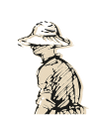Growing wild plants for the garden
When I was (or was) younger, say 12 years old, I didn't have the means to garden other than growing wild plants. It wasn't with 30 francs of pocket money a month that I could buy seeds and plants to satisfy a nascent and all-consuming passion for gardening.
When my parents moved into their house, they gave me a plot of land about ten square meters in which I grew what we now crudely call weeds. I found this mini-garden beautiful, because it was mine, all mine... Before studying horticulture, much later, I began to study wild flora with the innocence of my young age and a single book (which I still have) called "Flora of Europe".
Looking back, I now admire the clever and ultimately ahead-of-my-time approach I took at the time. I would look at the plants sold in garden centers and try to find a free equivalent in nature. Here's an example: I was looking for a plant to put in my small garden, similar to the snapdragon. That's how I discovered a small wild plant with yellow flowers almost identical to snapdragons: the common toadflax. Having realized that collecting them from the wild and transplanting them in my piece of land wasn't very conclusive, I collected the seeds of the said plant to cultivate it successfully, to the great despair (and a little amusement) of my parents who didn't understand this passion for weeds...
Why am I telling you all this? In fact, these memories resurfaced recently during an exchange with a project manager at the Botanic garden center chain, with whom a partnership was established through discussions with certain bloggers. They asked me what I thought of the space dedicated to hedges that they had set up on their site. Botanic offered shrubs, certainly very pretty, but only horticultural varieties. However, horticultural shrub varieties do not have optimal ecological value compared to so-called "wild" shrubs that were once found in the many bocages. So I replied to them: why not integrate "non-horticultural" plants into their range to accentuate the biodiversity aspect? At the same time, I wondered if there were producers crazy enough to cultivate wild shrubs and sell them to a garden center.
The answer came to me 3 weeks later while reading the horticultural link (professional press) of November 14, 2012. An article about a young nursery in Bruz, south of Rennes (35) caught my attention. Floridée'o, the nursery in question, run by Mathilde Radenac and Thao Ngo, specializes in growing local wild plants. Thanks to agreements with municipalities, the two creators of this nursery collect cuttings and seeds in the natural environment to cultivate them. The plants thus obtained are sold to eco-gardeners, eco-designers, municipalities, landscapers and to individuals at plant fairs.
But are today's gardeners and consumers willing to buy these types of plants that don't fit the current standards of plant beauty? Would you be willing to pay to buy a plant or shrub that you would find growing naturally in a forest or meadow near your home?
Jean-Marc Chery/Hortiman
Garden Planet





